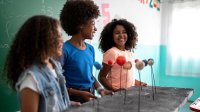Using Frequent Feedback Cycles to Guide Student Work
When students complete several drafts of a project and get feedback each time, they achieve better results.
Your content has been saved!
Go to My Saved Content.A big part of being a teacher is giving students the right kind of feedback. I’m a proponent of education researcher John Hattie’s view of feedback. He said, “While teachers see feedback as corrections, criticism, comments, and clarifications, for students unless it includes ‘where-to-next’ information, they tend to not use it.”
Kids, therefore, need feedback they understand and can readily act upon along the continuum of the learning process. They also need to be involved and invested in the feedback. So whether facilitating a project-based learning (PBL) unit or a performance task, I prefer to hold projects for two to three weeks and for my students to complete their products in three to four drafts using straightforward rubrics and critique protocols.
To activate frequent feedback cycles, I skimp on lengthy whole-group lessons to work with smaller groups to model, remediate gaps in previous learning, and reteach vital concepts as needed. Therein, I like to manage lessons, activities, and learning in the following four-step process within a workshop model–inspired structure:
- Mini lesson (10–15 minutes).
- Work time and reflection (35 minutes).
- Feedback protocol (10–15 minutes).
- More work time for either revision or continuing to the next draft and reflection (35 minutes). These timings are for two class periods at 50 minutes each. Adjust time frames depending on the length of your teaching block.
It’s not perfect, but it’s a structure I’ve used successfully to keep learning organized and evaluate students’ work as they use feedback to revise their drafts. This practice uses scripted educational protocols with influences that positively affect student learning, as ranked and supported by Hattie's visible learning research.
For example, practices affirmed by Hattie’s work, such as small group learning, evaluation and reflection, and strategies emphasizing feedback, are shown to have positive effects on students’ learning and can support them in completing products in drafts.
The caveat here is that we need to model the strategies frequently and in ways that help learners accurately understand performance expectations and how to seek assistance when they don’t. By giving them the right tools to participate in their own rescue, they can become more independent learners over time.
Two Tools to Provide Better Feedback
1. Single point rubrics. A teacher friend introduced me to single point rubrics (SPR) for getting kids to discuss their learning and feedback. An SPR displays criteria for a single level of achievement. It also includes an open space for feedback, goal setting, or evidence. SPRs can be used for evaluation and reflection during a feedback protocol (e.g., Gallery Walk, Critique Protocol). They are easy to design, as they have the criteria descriptors in only one column.
My SPR adaptation has four columns with the following headers:
- Emerging
- Proficient
- Highly Proficient
- Score
Only the Proficient column articulates the learning goals for a specific product or task.
Both the Emerging and Highly Proficient columns begin blank, allowing students ample space to audit their own practice and receive more helpful feedback that addresses critical problem areas and notable areas of excellence. Similarly, the Score column is also blank, and a five-point grading scale can be completed for each learning goal.
Additionally, a Jennifer Gonzalez post has several templates for SPRs linked by her and others in the comments section.
2. Structured-feedback protocols. Protocols like TAG Feedback (for K–5), Critical Friends, and Charrette can be adapted to help students fine-tune their products and performance tasks in drafts. Critique Protocol by EL Education is my favorite—here’s how it inspired the way I scaffold the process for students taking turns requesting and providing feedback.
Step 1: The presenter explains their product draft and requests feedback while their peer(s) listen (2 minutes). Good norms to lift up here are for the presenter to use language from the learning goal(s) they’re addressing and for the peer listening to take notes. Students more experienced with the feedback process can also grade and complete the empty columns in an SPR.
Step 2: The audience asks the presenter clarifying questions for supporting their feedback. The presenter should respond.
Step 3: To begin with glows, the audience shares what they saw and heard that was in alignment with the performance expectations. The presenter listens.
Step 4: The audience shares concerns about the lack of follow-through of performance expectations or needs for further improvement. The presenter listens and can also update the SPR or take notes.
Step 5: Finally, the audience shares ideas and resources for improving the product draft. The presenter can take notes and respond.
You can download a kid-friendly short version of the protocol I created for my work.
